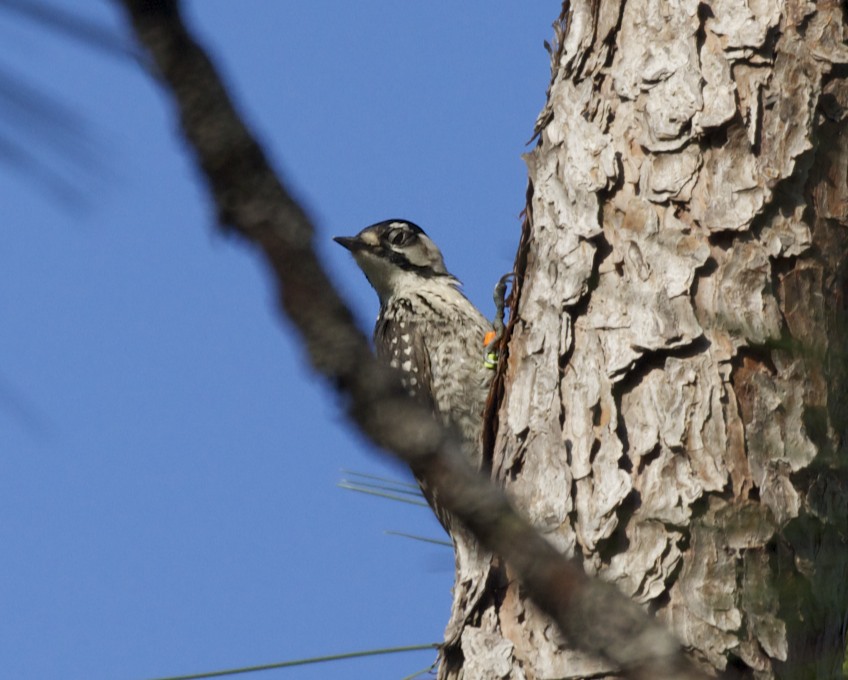The Butler's Birds Texas Adventure started out with a delectable appetizer of Painted Buntings outside San Antonio and then continued the next morning with endangered Black-capped Vireo and Golden-cheeked Warbler. After recording a clean sweep pretty early, I headed south to what is both harshly and accurately called the a**hole of Texas: Laredo.
Of about three sites ID'd as good for White-collared Seedeater--the main reason to go to Laredo--Zacate Creek seemed like the most contained and easy to find (anyone else get overwhelmed when you're at a massive new site with 50 trails? So much nagging and doubt...).
The place was totally trashy, with trails in disrepair and garbage all along the river banks, which served to accentuate the miasmic air blowing through the tall cane on the banks. Plus I was accosted several times by ICE agents, one of which ruined a perfectly good Green Kingfisher stakeout that was about to pay dividends for me, and one of which involved a fellow gun-in-hand (not pointed though). But damn, the birding here was phenomenal, and I caught a break from the cloud cover in the late afternoon (coincidentally, the hottest time of day).
White-collared Seedeater was actually the third bird I had by the Zacate River, behind MODOs and GTGRs. Hearing and seeing these tiny birds would prove to be pretty easy. Photographing them was another beast entirely, a sweaty, smelly, swampy beast.
Since the Seedeaters were a relatively easy find, I spent more time exploring the trials and other habitats around Zacate Creek. Green Jays, Golden-fronted Woodpeckers, and a couple of Green Kingfishers made for exciting year birds and solidified the tropical feel of the area. Great Kiskadees were sounding off from the trees, their boisterous betraying how shy of birds they really can be, and a couple of Olive Sparrows further boosted the day's species list.
Exploring the thicker palm groves yielded fewer birds overall, relative to the thick riverside tamarisk and cane, but this unique vegetation provided the only Audubon's Orioles of the trip. Including the birds from Kerr WMA in the morning, this added to seven lifers, probably the most I've recorded in a single day in several years. Zacate was a dank and dirty place, but it was productive.
Although it was late in the season, a lingering Black-throated Green Warbler was feeding in the mesquite canopies at the end of the trail--the first Texas bird that would flag and require an eBird justification, given its tardiness. These are, I will somewhat ashamedly and somewhat unashamedly admit, my only photos of the species to date. To all haters out there I simply say...zee zee zee zoo zee!
The Seedeaters stayed high and far throughout the afternoon, offering poor photo ops and better binocular views. As the sun started to descend the number of ICE agents in the area increased, anticipating the push of immigrants that comes every evening.
At this point in the day I was pretty tan and had left my wallet (and ID) in the locked glove compartment of my car as a precaution. Not wanting to be profiled and rounded up, I decided to call it a night, after finding some public showers, because using the Zacate River would've exacerbated things.

The next morning saw the first big busts of the trip, which luckily had nothing to do with windows, tires, or other parts of the car, nor my face. I had hit all the Laredo targets--and then some--at Zacate the first afternoon, but figured I'd try a few more sites recommended form the Texas Birding Trails website.
It turns out that site was a bit out of date. One of the areas has since been totally leveled and turned into a gated community with no surviving wetlands (except a duck pond) and another required advanced notice and a $40 entrance fee.
Instead of doing that...I went to the beach.
Driving across the Texas fin from Laredo to Corpus Christi, there were several dozen Crested Caracaras adorning various pedestals. While I didn't stop to photograph them (high, telephone poles, etc.), I must say this is probably the best highway roadside bird one can ask for in the U.S.
When one arrives on the Texas/Gulf Coast in June, one is beset by Laughing Gulls. Hundreds and Thousands of Laughing Gulls. Try to pick out the occasional late Franklins, even a Ring-billed--I did a couple of times--but you will also go mad and begin laughing manically too, just like the Gulls that have hounded and driven you to this point wherever this sand and/or garbage.
Still, they're pretty good looking Gulls.

There was some time to kill in Corpus before picking up The Iowa Voice in the evening for several days of joint birdventuring, so I used it to scan the Corpus Christi tidal flats and pick up some more diarrhea. I didn't know it at the time, but Corpus really is a great birding area with many more sites where at I could've better spent time. Relaxing around the easy-access beaches was nice though, no doubt, and still provided some nifty birds. Willets are an uncommon but reliable find in Arizona. Of course in Texas, they're among the most common shorebird in June.
The lifering continued via some Wilson's Well-Endowed Plovers. With their slightly but noticeably longer beaks, this species will eventually drive all other similarly sized Plovers to extinction.





























































